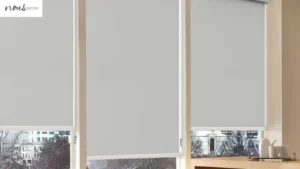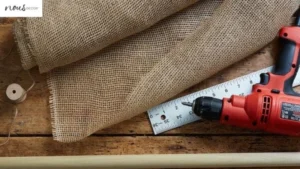Measuring for roller shades can seem like an intimidating task, but it doesn’t have to be. With a few simple measurements and the right brackets, you can install your own roller shades in no time.
We at Nousdecor are going to show you How To Measure For Roller Shades so that you don’t end up with an ill-fitting window treatment. Whether you’re mounting inside or outside of your window frame, these steps will help ensure that your new roller shade fits perfectly.
Key Takeaways of How To Measure For Roller Shades
- Measuring accurately is essential for ensuring a good fit and smooth operation of roller and solar shades.
- Different types of shades require different measuring techniques, such as inside and outside mount measurements for horizontal and vertical blinds.
- Consider factors such as fabric type, opacity, and durability when selecting shades.
- Proper installation requires the use of appropriate tools, such as a steel tape measure, drill, screws, and wall anchors.
Preparing to Measure for Roller Shades

Before I begin measuring for roller shades, I need to be sure that I have all the necessary tools and materials. To properly measure for roller shades, you will need a steel tape measure, a pencil or pen, and a piece of paper.
Once you have these items handy, you can start taking measurements and writing them down so you know exactly what size window shade to purchase.
Tools
To measure for roller shades, you’ll need a few tools: tape measure, pencil, and level. Taking accurate measurements is important for getting the right fit.
- A tape measure will help you get the exact length and width of your window frames so you can order the right size shade.
- A pencil will allow you to mark down any notes that are needed during the measuring process.
- And to make sure your window treatments hang straight and even, use a level to check if everything is perfectly aligned.
All these tools are necessary for successful installation of roller shades (see step-by-step roller shade installation for more info). With them in hand, it’s time to prepare the materials for installation.
Materials
Gather the materials you’ll need for installing your roller shades: a drill, screws, and wall anchors. Additionally, you’ll want to have a measuring tape or ruler on hand in order to get accurate measurements of the area where you plan to hang your roller shade.
It’s also important to ensure that any window hardware is installed and secure before attempting installation of the roller shade itself. With these materials in hand, you are ready to begin understanding the different types of roller shades available.
Understanding the Different Types of Roller Shades
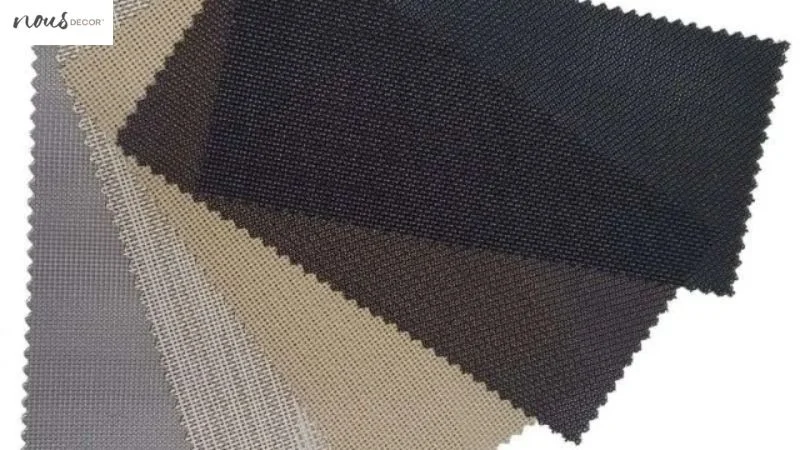
Understanding the different types of roller shades is key – they come in a range of fabrics, colors, and styles!
Roller shades are typically divided into two categories: light-filtering and blackout. Light-filtering shades have some light permeability, while blackout shades block out most or all light. Within these two categories there are further distinctions based on fabric type and color:
- Light Filtering Fabric – Sheer to semi-sheer fabrics that allow for diffuse lighting. Available in various colors and textures.
- Solar Screen Fabric – Sunscreen fabric that blocks UV rays but still allows some natural light to enter the space. Comes in solid colors or patterns with varying opacity levels from sheer to opaque.
- Blackout Fabric – Heavy weight fabric that blocks out nearly 100% of incoming light, providing complete privacy and darkness when drawn shut. Available in both solid colors or textured patterns with matte finishes which also help reduce glare from outdoor lights at night.
- Room Darkening Fabric – Semi-opaque fabrics provide privacy during the day yet still allow a bit of natural light to filter through when drawn open . These come in a variety of colors with subtle sheens for added interest and texture .
Roller shades offer an array of choices so you can find something that perfectly suits your home decor style while also meeting your functional needs such as controlling light levels, temperature control, noise reduction, etc..
With all these options available, it’s important to consider carefully what type best meets your requirements before proceeding to measure the inside mount.
Measuring the Inside Mount
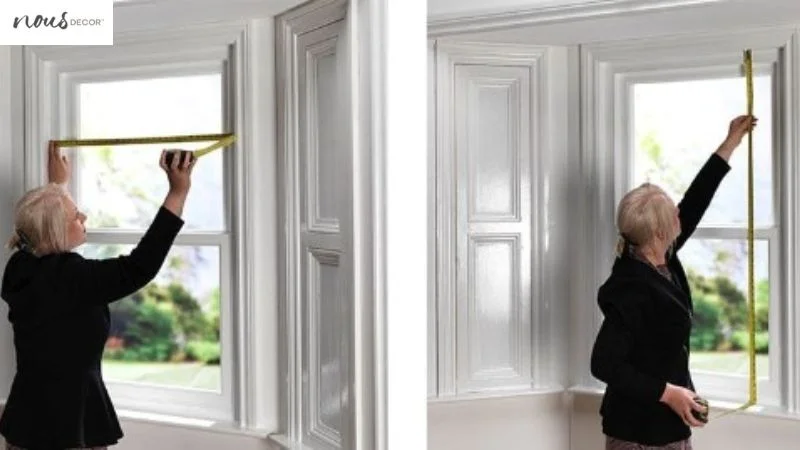
Measuring for inside-mounted horizontal blinds is a simple process.
- First, I measure the width of the window opening at each end and in the middle.
- Then, I measure the height from top to bottom in three spots: at each side and in the middle.
- Finally, I measure on a diagonal from corner to corner to guarantee an accurate fit.
With these measurements in hand, I’m ready to select my inside-mounted horizontal blinds.
Measure the Width
To get the perfect fit for your do-it-yourself roller shade ideas, you’ll need to measure the width.
Measure at the top and bottom of the window opening in three places: left side, middle, and right side. Use a metal tape measure to ensure accuracy and mark each measurement with a pencil on the wall or frame.
Record each of these measurements on paper. When there are discrepancies between measurements, use the smallest width measurement when ordering your shade – this will guarantee that your shade fits properly inside your window opening.
The next step is to measure the height of your window.
Measure the Height
Now that you have the width of your window measured, it’s time to measure the height. To ensure that your roller shade will fit perfectly, take these steps:
- Measure from the top of the window trim or casing to the floor or windowsill.
- If installing inside a window frame, make sure to leave an extra 1/2 inch for mounting brackets and hardware.
- Measure both sides of your window in case one side is slightly deeper than the other.
- Record all measurements in inches and use the longest measurement when ordering a roller shade for an inside mount installation.
With this information handy, you’re ready to measure on the diagonal so you can find out what size roller shade is best for your needs!
Measure on the Diagonal
To guarantee you get the perfect roller shade for your window, measure it on the diagonal for an accurate fit.
Using a steel tape measure, start at the top left corner of your window and measure in a straight line diagonally to the bottom right corner. Be sure to record both measurements as they may differ slightly.
If you’re looking for maximum light filtering or complete blackout protection, keep in mind that shades installed within ¼-inch of their exact measurements will give you the best coverage.
With precise measurements in hand, you can now confidently select your inside-mounted horizontal blinds that will provide just the right amount of privacy and design aesthetic for your home.
Select Your Inside-Mounted Horizontal Blinds
With precise measurements in hand, you can confidently select the perfect inside-mounted horizontal blinds to give your window the desired amount of privacy and style. Whether you’re looking for a classic look or something more modern, there are so many options to choose from:
- Wood blinds that provide a warm touch of nature to any space
- Faux wood materials that offer durability at an affordable price
- Vinyl shutter slats with an elegant, timeless design
Finding the right type of window treatment can be overwhelming but with careful consideration and quality measuring, you’ll find the perfect fit for your home.
Now that you know how to measure for inside-mount horizontal blinds, it’s time to switch gears and focus on measuring for outside-mount shades.
Measuring the Outside Mount
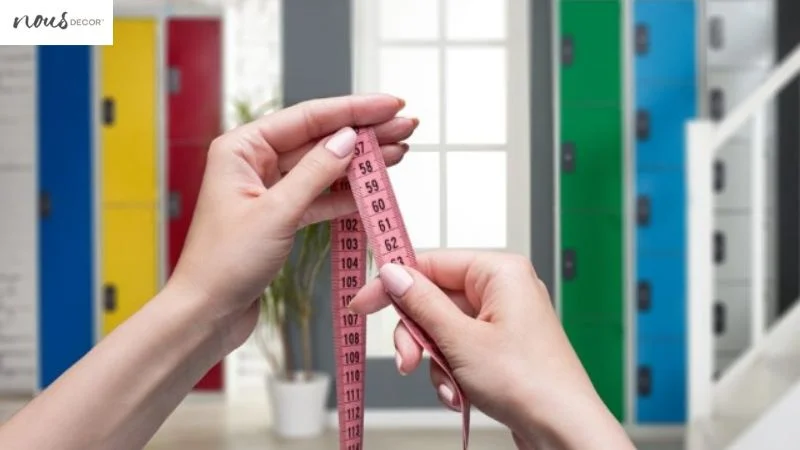
Measuring for outside mount horizontal blinds is a fairly straightforward process.
- First, you’ll need to measure the width of the window from one side trim to the other.
- Next, you’ll need to measure the height from where you want your blinds to be mounted up until the top of your window.
- Once you have these measurements, select your outside-mounted horizontal blinds and make sure they come with extension brackets if needed.
Measure the Width
Accurately measuring the width of your roller shade is essential for creating a custom fit.
It’s important to have reliable measurements so that you can order the perfect size and ensure it fits correctly when installed. Here are three steps to make sure you get accurate width measurements:
- First, measure from one side of the window frame or wall edge to the other, noting any obstructions like trim or molding that could interfere with installing the blinds.
- Secondly, provide an extra 1/4 inch clearance space around your window opening so that your roller shades won’t be too tight when they’re fully extended.
- Finally, check twice and double-check your measurements before submitting them for ordering to avoid problems due to incorrect measurements.
Taking these steps will help you get a perfect fit on your roller shades! Next up is measuring the height of your window opening for optimal installation.
Measure the Height
Now that you have the measurements for the width of your roller shade, it’s time to measure for the height. You’ll need a steel tape measure and a sturdy step-stool or ladder if necessary. Start at the top of your window frame and measure down to where you want your roller shade to end.
Make sure that you don’t include any overlap in this measurement. When measuring, keep in mind that many shades require an inch or two of extra space above and below them so they can be installed properly.
Once you have measured the height, it’s time to move on to selecting your outside-mounted horizontal blinds. The type of blinds you choose will depend on what style best fits with the décor in your home and how much sunlight control you need.
Remember to account for any extra space needed when making your selection!
Select Your Outside-Mounted Horizontal Blinds
Choose the perfect horizontal blinds for your home to create a stylish look and get just the right amount of light!
Whether you prefer a modern, contemporary look or something classic, horizontal blinds come in a variety of colors and textures.
- Choose an opaque fabric for greater privacy when closed.
- Consider wood or faux wood materials for an elegant style that also adds texture to your room.
- Opting for aluminum or vinyl slats offers durable construction and easy maintenance.
- Select from a range of sizes and widths to ensure the best fit for your windows.
Once you’ve chosen your horizontal blinds, be sure to get extension brackets if needed so they can hang properly on outside-mounted window frames.
Get Extension Brackets if Needed
If you have an outside-mounted window frame, it’s essential to get extension brackets so that your horizontal blinds can hang properly. Extension brackets are available in a variety of sizes and styles, making them perfect for any window or décor.
Make sure to measure the exact height and width of your window before purchasing the brackets, as well as measuring the depth from the wall to ensure they fit properly over your window frame.
Once you find the right set of extension brackets for your project, install them according to manufacturer instructions so that your roller shades can hang securely on either side.
With these steps completed, you’ll be ready to move onto measuring for inside-mounted vertical blinds.
Measuring for Inside-Mounted Vertical Blinds
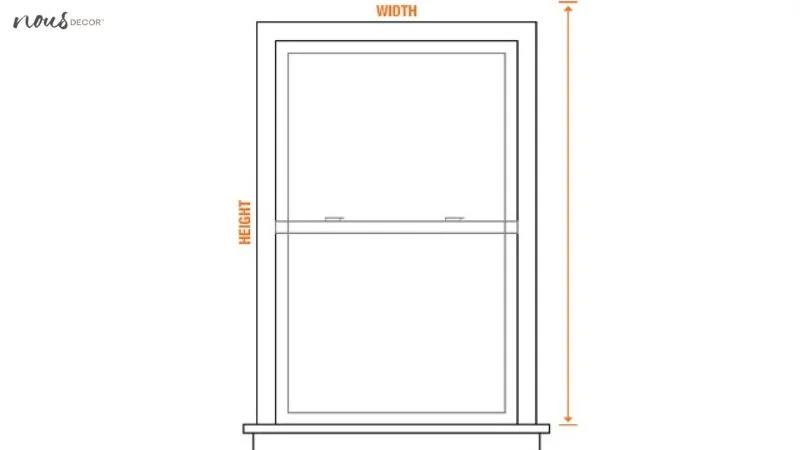
When measuring for inside-mounted vertical blinds, it’s important to consider the depth of the window sill and the size of the headrail in order to ensure a proper fit. Here are some tips to help you get started:
- Measurements:
- Measure the width of your window opening at three different points — top, middle and bottom. Record the smallest measurement as this is what will be used for purchasing your blinds.
- Measure from inside edge to inside edge of window casing or walls on both sides and top of window frame.
- Headrail:
- Be sure that your headrail is slightly narrower than your window opening. This will allow for a better fit and also provide room for installation brackets.
- Make sure that there is enough room between headrail and wall or windowsill so that it won’t rub against either when opened or closed.
- Window Sill Depth:
- The depth of your windowsill should be considered when selecting an inside mount shade because this determines how far away from the wall or windowsill they’ll hang down from.
- You don’t want them too close where they might obstruct outside views or not fit properly within the space allotted by your windowsill depth.
By carefully considering these factors, you can make sure that you get just the right size shade for your particular needs.
With accurate measurements in hand, you’re ready to move on to measuring for outside-mounted vertical blinds – another important step in getting just the right roller shades explained for your home!
Measuring for Outside-Mounted Vertical Blinds
Measuring for outside-mounted vertical blinds requires precise measurements to ensure they fit perfectly and provide the desired level of privacy and light control.
In order to take accurate measurements, you will need a metal tape measure and a pen or pencil to record the numbers. Measure from the top of your window frame where the blinds will be mounted down to the bottom of your window sill.
Then, measure across the width of your window frame from one side to another, making sure that you include any obstructions like handles or cranks in your measurement. Finally, add 3 inches onto each measurement when ordering so that you have enough fabric for a proper fit.
It is important to remember that if there are any obstructions in or around your window which could prevent an inside mount installation, you may need to consider mounting outside instead.
To do this, create a frame by attaching wood planks along three sides of the perimeter of your window opening with L brackets; then attach vertical blinds directly onto it using screws and anchors. This method should help ensure a secure fit without drilling into walls or window frames.
Outside-mounted vertical blinds can be an effective solution for controlling light levels while providing ample privacy if installed correctly – just make sure that you take accurate measurements beforehand!
Measuring for Vertical Blinds for Patio Doors
To get the perfect fit for your patio door, you’ll need to take some precise measurements before ordering vertical blinds. Here are four things to consider when measuring:
- Measure the width of your patio door opening in three places – from the top, middle and bottom – and use an average of those measurements.
- Measure the height from the top of your window frame to where you want your vertical blinds to hang. When installed on a patio door, vertical blinds should be mounted just above or below the window frame.
- If you’re using a valance with your vertical blinds, add 3-4 inches of additional length to allow for it when making your calculations.
- Before ordering, double check all of your measurements one last time!
Installing vertical blinds over a patio door can be tricky if not done correctly – make sure that all measurements are accurate before purchasing so that you don’t have any surprises come the delivery day!
With these detailed measurements in hand, you can order with confidence knowing that you’ll get exactly what will fit perfectly in your space without any hassle or delay caused by incorrect sizing information.
Taking the time upfront to ensure accuracy will save headaches down the road and help create an ideal look for your patio door area! Now on to measuring for inside-mounted roller and solar shades…
Measuring for Inside-Mounted Roller and Solar Shades
Now that you know how to measure for vertical blinds for patio doors, let’s move on to the next step: measuring for inside-mounted roller and solar shades. First, decide where you want the shade to hang by determining if you prefer it to be installed within the window frame or slightly outside of it.
When measuring within a window frame, use a steel tape measure (not a fabric one) and take three measurements at the top, middle, and bottom of the opening. Make sure the measurements are level and in inches from the left side of the window jamb to the right side of the jamb.
Record your measurements with accuracy because these will be needed when ordering your shade.
When measuring outside of a window frame, start at one end of the area where you want your shade to hang and measure across in width and then up in height; make sure to add four inches onto each measurement so that when installed, there will be two inches extra on each side from wall surface which allows room for easy operation.
Also, note that all rolls should have an overlap between them as well as non-operational width added onto each side if they are being used over multiple windows connected together.
Once you’ve taken all necessary measurements accurately according to shape, size, and location preferences – it’s time to learn about how best to measure for outside-mounted roller or solar shades.
Measuring for Outside-Mounted Roller and Solar Shades
Installing roller or solar shades outside of your window frame can add a decorative touch to your space, but before you get started it’s important to take accurate measurements.
When measuring for outside-mounted roller or solar shades, measure the entire width and height of the area in which you’d like to install them, including any trim or molding. Be sure to include enough extra width and height so that the shade clears all obstructions when fully raised.
To ensure an exact fit, make careful note of any irregularities in the surface where you will hang them – such as corners or uneven walls – as this may require custom sizing.
When taking measurements, always use a metal tape measure rather than cloth or plastic. Double-check your measurements at least twice to avoid costly mistakes.
It is also recommended that you round up each measurement by about 1/4 inch just to be on the safe side; too small an opening may impede the operation of the shade while too large an opening may cause light gaps around its edges.
Additionally, when ordering online be sure to double-check that you have selected the appropriate size according to their unit of measurement (inches, centimeters).
Finally, regardless if they are inside-mounted or outside-mounted roller and solar shades, keep in mind that precise measurements are essential for ensuring a good fit and smooth operation; with these tips in hand, you’ll be well on your way toward creating beautiful unique windows!
With this knowledge under our belt, we can now move on to measuring for vertical blinds for french doors.
Measuring for Vertical Blinds for French Doors
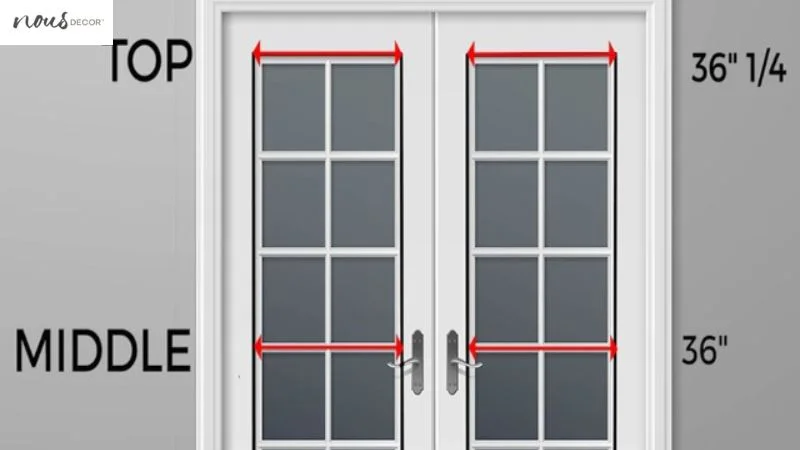
Measuring for vertical blinds on French doors is a breeze; just be sure to round up each measurement by a quarter inch to ensure an exact fit.
To begin, measure the width of the door from jamb to jamb at three different points: at the top, in the middle, and at the bottom. Record all measurements and add them together before dividing by 3 to get your average width measurement.
Then measure from the finished floor to the finished ceiling on both sides of the door frame and record these measurements as well. When you have taken all your measurements, you can calculate the shade width and length accordingly.
Next, use a metal tape measure—a cloth one may stretch over time—to determine how wide each panel needs to be. The standard size is about 8-10 inches but be sure to consult with your supplier first as sizes may vary depending on what type of blinds you are buying.
If you’re ordering custom-made shades, make sure that they are wider than your widest point of measurement so that they will cover it completely when fully closed.
Finally, it’s important to leave some room between each window panel if there are more than one installed in order for them to open properly without blocking one another or hindering movement inside or outside of the French doors area. Leave about two inches between panels for optimal performance throughout their lifespan.
By following these simple steps, measuring for vertical blinds for French doors should now be easy!
Calculating the Shade Width and Length
Once you’ve got the measurements, calculating the shade width and length is a breeze! To calculate the width of your roller shade, you need to take into account the size of your window.
Measure from one side of the window frame to the other side and add at least six inches for overlap coverage. Do not include any molding or casing when measuring. For inside mount shades, you will want to subtract 1/2″from each side. This will ensure that there is enough space between the edge of your roller shade and the sides of your window opening.
When measuring for height, measure from top to bottom in three different spots and use the longest measurement as your finished height measurement. Include all moldings in this measurement since they are typically taken off during installation anyway.
If you have an inside mount situation, make sure to deduct 1/4″so that there is room for proper clearance between the top rail and headrail on your roller shade when it’s installed.
Now that you have both width and length measurements handy, it’s time to move onto choosing a shade mount option: either an outside or inside mount situation based on whether or not you plan on covering up existing trim or just wanting a neat fit within an existing window frame!
Choosing a Shade Mount
It’s time to decide which shade mount option is best suited for your needs, whether an outside or inside mount situation. An outside mount will cover the entire window frame and may be necessary if you have a deep window frame, while an inside mount can provide a sleeker look and fit within the window frame itself.
To choose an outside mount option, measure from left to right at the top of the window and then again at the bottom. The wider measurement should be used for ordering purposes since it will need to cover more space.
For an inside mount, measure from side to side three times – once at each end and once in the middle – then use the narrowest measurement when ordering your shades.
When it comes to measuring for height, take three measurements as well – one on each side of the window frame and one in between them – then select the longest length needed for proper coverage.
You’ll also want to check that there is enough depth available within your window frame so that all mechanisms required by your chosen roller shade are able to fit properly. This includes brackets, mounting hardware, cords, etc., depending on what type of shade you’ve selected.
Choosing a shade mount doesn’t have to be complicated; just make sure you take accurate measurements so that when selecting brackets later on, they’ll properly fit into place and hold securely over time.
With careful attention paid here upfront during decision-making stages of this process, all other steps should fall into place nicely leading up to installation day! Time now turn our attention towards selecting the right brackets…
Selecting the Right Brackets
Now that you’ve taken the time to choose a shade mount, it’s time to select the right brackets for your roller shades. Depending on which type of shade mount you chose, there are different types of brackets available:
- Wall-mounted brackets – These are suitable when mounting shades directly onto walls.
- Ceiling-mounted brackets – These are ideal for mounting shades onto ceilings or other overhead surfaces.
- Recessed wall-mounted bracket – This type is great for mounting shades in a recessed area such as between two windows or inside window frames.
When selecting the right bracket size, make sure to measure twice and buy once! Measure the width of the window opening; then subtract 4 inches from that measurement to determine your bracket size.
For example, if your window opening measures 36 inches wide, then you will need 32-inch long brackets for your roller shade. Be sure to double-check all measurements before making any purchases!
It is important to ensure that you have selected the correct mounting option and bracket size required for installing roller shades correctly and securely. With some careful measuring and planning ahead, you can now move on to choosing a shade fabric that suits your needs best.
Choosing a Shade Fabric
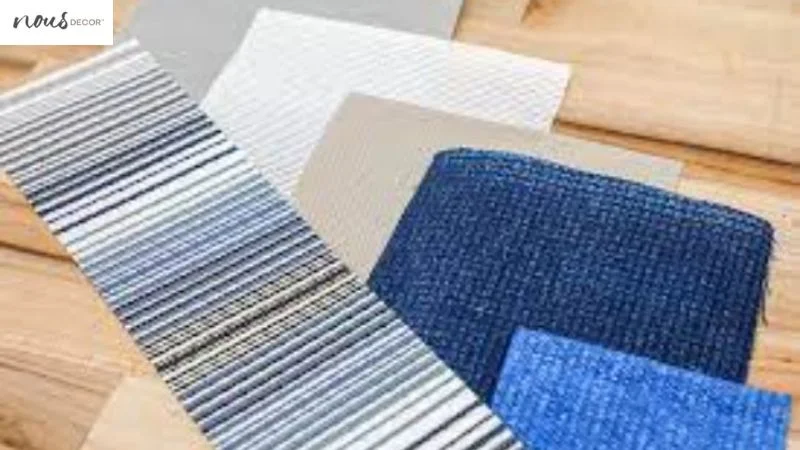
With the right mounting and brackets in place, it’s time to select a shade fabric that meets your needs. There are many options available, so research is key when making this decision.
Consider factors such as how much light you want to let through the shades, the room’s decor style, and which colors will best coordinate with your walls or furniture. You can also choose from fabrics that are more energy-efficient, blocking UV rays and keeping your home cooler in warmer weather.
Additionally, consider whether you’d like blackout or privacy liner fabric for extra insulation or privacy.
Another factor to consider when selecting a shade fabric is its durability—fabrics vary in terms of how well they hold up over time against fading due to sunlight exposure and other environmental elements.
It’s wise to invest in an option with a higher thread count if you want the fabric to last longer. With all these considerations made, you should have no problem finding the perfect roller shade fabric for your space!
Now that you’ve chosen your roller shade fabric as your unique household embellishments, it’s time to move on to installing them into place.
Installing the Roller Shades
Now that you’ve selected the perfect fabric for your space, it’s time to get those functional window solutions roller shades up and running! Before starting, make sure that all the necessary supplies are on hand. These include:
- a power drill with appropriate bit for making mounting holes
- screws of the right length for wall anchors
- a level for measuring straightness
It is important to measure accurately in order to ensure that your roller shades will fit properly. Measure from the top of your window frame, down to where you would like the bottom of your shade to hang.
Be mindful not to cut too much off or leave too much excess at the bottom when cutting. Once you have measured and marked off where you need to make mounting holes, use a power drill and an appropriate bit size for drilling into concrete or brick walls.
After securing each side with wall anchors and screws, slide in each side of the bracket into place then hang up your shade!
Finally, adjust accordingly until everything lines up according to plan. Make sure that everything is level by double checking with a leveler before calling it finished – now enjoy your new view out the window!
Frequently Asked Questions
Conclusion
Different window covering options have different ways to measure them.
Measuring for roller shades can seem like a daunting task, but with the right preparation and knowledge it’s easy. Knowing the type of shade mount you need, as well as what fabric and brackets you want makes measuring much simpler.
Once you know have your measurements, installing the roller shades is straightforward. With these tips in mind, I’m sure you’ll have no trouble learning How To Measure For Roller Shades and finding the perfect fit for your windows!




